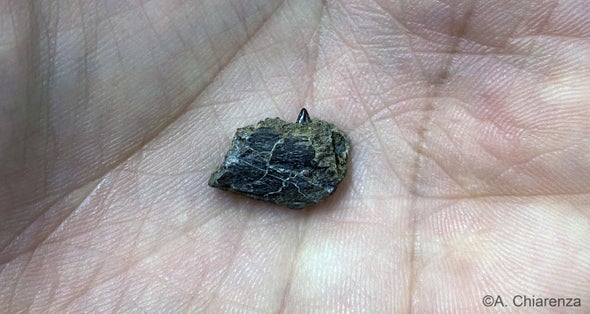(单词翻译:单击)
听力文本
This is Scientific American's 60-second Science, I'm Emily Schwing.
"Those vicious, predatory dinosaurs that tended to be fairly small—six- to nine-, 10-feet-long, snout to tail—they're certainly in the Jurassic Park movies, the things that terrorize people."
Anthony Fiorillo, a paleontologist at Southern Methodist University in Dallas, Tex. For more than two decades now, Fiorillo has been digging up dinosaur fossils hundreds of miles north of the Arctic Circle in Alaska.
"So one of the fundamental questions about dinosaurs in Alaska, in the ancient Arctic, is: Did they live there all year round? Did they migrate? How did they get there?"
A recent discovery sheds light on those questions.
"This fossil that's the subject of this study is a baby dinosaur. It's a baby predatory dinosaur, and it is a baby; it's not just a juvenile. And given the size estimate of this thing, this probably was not far from where the nesting ground was, so this is the first physical proof that at least some dinosaurs nested in the anciet Arctic."
Some of the first Arctic dinosaur remains ever found were discovered back in the 1960s in Svalbard, an archipelago north of mainland Norway. Since then researchers have theorized that dinosaurs must have migrated to avoid deeply cold winters. But Fiorillo says this new discovery disproves that idea.
"Well, you know, the classic stereotype for dinosaurs is that—had been that—they were living in tropical and subtropical environments, sometimes somewhat swampy. If you look at the various artworks over generations, that was quite often how these dinosaurs were reconstructed."

In reality, the climate north of Alaska's Brooks Range 70 million years ago was similar to what we might see today in Portland, Ore., or Calgary, Alberta.
"Certainly a place where things were cooler or capable of being cool at times but certainly warmer than the Arctic today."
The fossil find is a piece of jawbone, with a tooth, from a dromaeosaur. Fiorillo and colleagues unearthed it along the banks of the Colville River, not too far from the Arctic Ocean. The bone is the first nondental evidence of that species in the far north. The researchers report their discovery in the journal PLOS ONE.
Of course, questions remain:
"How did they do what they did? Because even with the warmer temperatures, at the latitude that these dinosaurs were living, which is at least 70 degrees north, if not even farther north, how did they endure long periods of light and dark?"
And that's where the research will go next. For now, Fiorillo says the new discovery proves that these giant reptiles were well adapted to the highly seasonal environments of the Late Cretaceous that we still experience today in the Arctic.
Thanks for listening for Scientific American's 60-second Science. I'm Emily Schwing.
参考译文
这里是科学美国人——60秒科学系列,我是埃米莉·施温。
“那些凶残的食肉恐龙往往体型相对较小,从鼻子到尾巴大概6到9或10英尺长,它们肯定是《侏罗纪公园》系列电影中那些让人恐惧的东西。”
得州达拉斯南卫理公会大学的古生物学家安东尼·菲奥里洛说到。20多年来,菲奥里洛一直在阿拉斯加北极圈以北数百英里处挖掘恐龙化石。
“关于远古北极阿拉斯加恐龙的一个基本问题是:它们全年都生活在那里吗?它们是否迁移?它们是如何到达那里的?”
最近的一项发现揭示了这些问题。
“这项研究的主题是一只恐龙宝宝的化石。这是一只食肉小恐龙,它是婴儿恐龙;不是幼年恐龙。考虑到这颗化石的大小,它可能离筑巢地不远,因此这是首个实体证据,证明至少有一些恐龙在远古北极筑巢。”
早在上世纪60年代,挪威大陆北部的斯瓦尔巴特群岛就发现了首批北极恐龙遗骸。从那时起,研究人员就推测恐龙一定是为了躲避严寒的冬季而迁徙的。但菲奥里洛表示,这项新发现推翻了这个观点。
“之前人们对恐龙的经典刻板印象是,它们生活在热带和亚热带环境中,有时环境中会有沼泽。如果你观察历代各种艺术品,你会发现这些恐龙往往就是这样被重建的。”
事实上,7000万年前阿拉斯加布鲁克斯山脉以北的气候,与我们今天在俄勒冈州波特兰或阿尔伯塔省卡尔加里看到的气候相似。
“当然,在那个地方,物体有时能保持凉爽或更冷,但肯定比今天的北极更温暖。”
这次发现的化石是带有一颗牙齿的奔龙颌骨。菲奥里洛和同事在离北冰洋不太远的科尔维尔河岸挖出了这块化石。这块骨头是该物种在遥远北极的首个非牙齿证据。研究人员在《公共科学图书馆·综合》期刊上报告了他们的发现。
当然,问题仍然存在:
“它们是如何做到的?因为即使在温度更高的情况下,在这些恐龙当时生活的纬度即至少北纬70度,如果不是更北的话,它们是如何忍受长时间的光照和黑暗的?”
这就是下一步研究的方向。菲奥里洛表示,目前新发现证明这些巨型爬行动物很好地适应了白垩纪晚期的季节性环境,而如今北极仍在经历这种环境。
谢谢大家收听科学美国人——60秒科学。我是埃米莉·施温。
译文为可可英语翻译,未经授权请勿转载!
重点讲解
重点讲解:
1. dig up 挖出;掘起;
You would have to dig up the plant yourself.
你得自己把那株植物挖出来。
2. be far from 远;遥远地;
The restaurant is not far from here.
饭店离这儿不远。
3. in reality 事实上;实际上;
He came across as streetwise, but in reality he was not.
他给人的印象是很适应都市生活,但实际上并非如此。
4. adapt to 适应;
The world will be different, and we will have to be prepared to adapt to the change.
世界会变得不同,我们必须做好准备以适应其变化。
关注微信公众号【可可双语精读】,获取详细讲解内容


